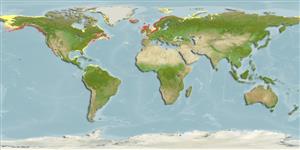Common names from other countries
Environment: milieu / climate zone / depth range / distribution range
Ecología
; rango de profundidad 0 - 60 m (Ref. 83435). Tropical
Distribución
Países | Áreas FAO | Ecosistemas | Ocurrencias, apariciones | Introducciones
Atlantic Ocean, Eastern Pacific, Arctic and the Mediterranean. Tropical to polar.
Length at first maturity / Tamaño / Peso / Age
Maturity: Lm ? range ? - ? cm Max length : 2.0 cm TL macho / no sexado; (Ref. 822)
Assumed maximum length from Ref. 822. This species is found on rocky shores particularly in bathyal areas of gulfs and estuaries. They feed on planktonic and minute detrital food items through suspension or deposit feeding (Ref. 87872). It was observed to feed on the bryozoans Alcyonidium, Electra, and Frustrella (Ref. 822).
Life cycle and mating behavior
Madurez | Reproducción | Puesta | Huevos | Fecundidad | Larva
Sexes are separate but are seldom conspicuously different externally, simultaneous hermaphrodites yet self-fertilization is prevented due to various morphological, physiological, or behavioral mechanisms; generally, marine gastropods shed their eggs (Ref. 87872).
Turgeon, D.D., J.F. Quinn Jr., A.E. Bogan, E.V. Coan, F.G. Hochberg, W.G. Lyons, P.M. Mikkelsen, R.J. Neves, C.F.E. Roper, G. Rosenberg, B. Roth, A. Scheltema, F.G. Thompson, M. Vecchione and J.D. Willams. 1998. (Ref. 1667)
IUCN Red List Status (Ref. 130435)
CITES status (Ref. 108899)
Not Evaluated
Not Evaluated
Human uses
| FishSource |
Herramientas
Más información
Age/Size
Crecimiento
Length-weight
Length-length
Morfología
Larva
Abundancia
Fuentes de Internet
Estimates based on models
Preferred temperature
(Ref.
115969): 4.3 - 14, mean 9.6 (based on 688 cells).
Vulnerability
Low vulnerability (10 of 100).
Price category
Unknown.
